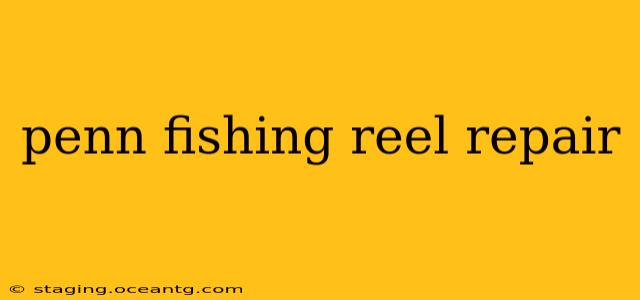Penn fishing reels, known for their durability and performance, can still require repair over time. Whether you're dealing with a simple drag adjustment or a more complex internal issue, understanding the process can save you money and keep your reel fishing strong. This comprehensive guide covers common Penn reel problems, troubleshooting tips, and resources to help you get your reel back in top condition.
What are the Most Common Penn Fishing Reel Problems?
Many Penn reel issues stem from saltwater exposure, lack of maintenance, or simply wear and tear from consistent use. Common problems include:
- Drag issues: This is frequently the first sign something's wrong. The drag might feel gritty, inconsistent, or fail to engage properly.
- Handle wobble: A loose or wobbly handle indicates potential problems with the handle screws or internal components.
- Gear noise or grinding: This often points to worn gears, requiring lubrication or replacement.
- Spool wobble: A wobbling spool can be due to bent shafts or other internal alignment problems.
- Line issues: Problems like bird's nests or line tangles could be due to worn components or improper spool setup.
How Can I Troubleshoot My Penn Fishing Reel?
Before diving into a full repair, try some basic troubleshooting:
- Cleaning: Thoroughly clean your reel with fresh water (especially important after saltwater use). Remove any built-up salt, sand, or debris.
- Lubrication: Apply a high-quality reel lubricant to the gears and other moving parts. Penn recommends their own branded lubricants, but others are available.
- Drag adjustment: Adjust the drag according to the manufacturer's instructions. This often resolves inconsistent drag performance.
- Inspection: Carefully examine the reel for any obvious damage, loose screws, or worn components.
What Tools and Parts Will I Need for Penn Fishing Reel Repair?
The specific tools and parts needed depend on the type of Penn reel and the nature of the problem. However, some commonly used tools include:
- Screwdrivers: Various sizes of Phillips and flathead screwdrivers.
- Pliers: Needle-nose pliers and possibly adjustable pliers.
- Reel maintenance kit: These kits often contain specialized tools and lubricants for reel repair.
- Replacement parts: Depending on the repair, you might need replacement gears, bearings, drag washers, or other internal components. Finding these parts may require contacting Penn directly or a reputable fishing supply store specializing in reel repair.
Where Can I Find Penn Fishing Reel Repair Manuals or Diagrams?
Penn provides resources to help owners with repairs. While they might not offer full step-by-step instructions for every model, finding schematics and part diagrams can be helpful. Checking Penn's official website or contacting their customer service is a good first step. Additionally, online forums and fishing communities often have dedicated threads for Penn reel repair, where experienced users share advice and tips.
Can I Repair My Penn Reel Myself, or Should I Take It to a Professional?
Whether you attempt a DIY repair depends on your mechanical aptitude and the complexity of the problem. Simple issues like drag adjustments or cleaning are usually manageable for beginners. However, more involved repairs involving internal components may require the expertise of a professional reel technician. If you're unsure, it's always better to err on the side of caution and seek professional help to avoid causing further damage.
How Much Does Professional Penn Fishing Reel Repair Cost?
The cost of professional Penn reel repair varies depending on the extent of the damage, the reel model, and the technician's fees. It's best to contact local fishing shops or specialized repair services for quotes before proceeding.
What is the Best Way to Prevent Penn Fishing Reel Problems?
Regular maintenance is key to extending the life of your Penn reel. This includes:
- Rinsing after each use: Especially important after saltwater fishing.
- Periodic lubrication: Lubricate the moving parts regularly.
- Proper storage: Store your reel in a cool, dry place.
- Regular inspections: Inspect the reel for any signs of wear or damage.
By following these tips and taking proactive steps, you can keep your Penn fishing reel in optimal condition for years to come. Remember, a well-maintained reel not only performs better but also increases its longevity and overall value.
